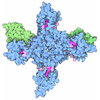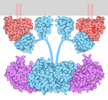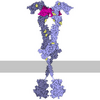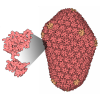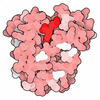+ Open data
Open data
- Basic information
Basic information
| Entry | Database: PDB / ID: 9u7f | ||||||
|---|---|---|---|---|---|---|---|
| Title | structure of human KCNQ1-KCNE1-CaM complex | ||||||
 Components Components |
| ||||||
 Keywords Keywords | MEMBRANE PROTEIN / Ion channels | ||||||
| Function / homology |  Function and homology information Function and homology informationvestibular nucleus development / negative regulation of protein targeting to membrane / secretory granule organization / gastrin-induced gastric acid secretion / corticosterone secretion / voltage-gated potassium channel activity involved in atrial cardiac muscle cell action potential repolarization / basolateral part of cell / lumenal side of membrane / negative regulation of voltage-gated potassium channel activity / rhythmic behavior ...vestibular nucleus development / negative regulation of protein targeting to membrane / secretory granule organization / gastrin-induced gastric acid secretion / corticosterone secretion / voltage-gated potassium channel activity involved in atrial cardiac muscle cell action potential repolarization / basolateral part of cell / lumenal side of membrane / negative regulation of voltage-gated potassium channel activity / rhythmic behavior / stomach development / iodide transport / regulation of gastric acid secretion / voltage-gated potassium channel activity involved in cardiac muscle cell action potential repolarization / Phase 3 - rapid repolarisation / regulation of potassium ion transport / membrane repolarization during atrial cardiac muscle cell action potential / membrane repolarization during action potential / telethonin binding / Phase 2 - plateau phase / regulation of atrial cardiac muscle cell membrane repolarization / intracellular chloride ion homeostasis / membrane repolarization during ventricular cardiac muscle cell action potential / membrane repolarization during cardiac muscle cell action potential / negative regulation of delayed rectifier potassium channel activity / potassium ion export across plasma membrane / renal sodium ion absorption / voltage-gated potassium channel activity involved in ventricular cardiac muscle cell action potential repolarization / atrial cardiac muscle cell action potential / membrane repolarization / auditory receptor cell development / regulation of membrane repolarization / protein phosphatase 1 binding / detection of mechanical stimulus involved in sensory perception of sound / delayed rectifier potassium channel activity / ventricular cardiac muscle cell action potential / potassium ion homeostasis / Voltage gated Potassium channels / positive regulation of potassium ion transmembrane transport / regulation of ventricular cardiac muscle cell membrane repolarization / cardiac muscle cell action potential involved in contraction / non-motile cilium assembly / outward rectifier potassium channel activity / cardiac muscle cell contraction / regulation of potassium ion transmembrane transport / epithelial cell maturation / CaM pathway / Cam-PDE 1 activation / intestinal absorption / Sodium/Calcium exchangers / Calmodulin induced events / Reduction of cytosolic Ca++ levels / Activation of Ca-permeable Kainate Receptor / CREB1 phosphorylation through the activation of CaMKII/CaMKK/CaMKIV cascasde / Loss of phosphorylation of MECP2 at T308 / CREB1 phosphorylation through the activation of Adenylate Cyclase / inner ear morphogenesis / CaMK IV-mediated phosphorylation of CREB / PKA activation / negative regulation of high voltage-gated calcium channel activity / Glycogen breakdown (glycogenolysis) / CLEC7A (Dectin-1) induces NFAT activation / Activation of RAC1 downstream of NMDARs / negative regulation of ryanodine-sensitive calcium-release channel activity / organelle localization by membrane tethering / adrenergic receptor signaling pathway / mitochondrion-endoplasmic reticulum membrane tethering / autophagosome membrane docking / negative regulation of calcium ion export across plasma membrane / regulation of cardiac muscle cell action potential / ciliary base / renal absorption / regulation of heart contraction / presynaptic endocytosis / protein kinase A regulatory subunit binding / Synthesis of IP3 and IP4 in the cytosol / protein kinase A catalytic subunit binding / regulation of cell communication by electrical coupling involved in cardiac conduction / Phase 0 - rapid depolarisation / potassium ion import across plasma membrane / calcineurin-mediated signaling / Negative regulation of NMDA receptor-mediated neuronal transmission / Unblocking of NMDA receptors, glutamate binding and activation / inner ear development / RHO GTPases activate PAKs / regulation of heart rate by cardiac conduction / Ion transport by P-type ATPases / Uptake and function of anthrax toxins / action potential / regulation of ryanodine-sensitive calcium-release channel activity / protein phosphatase activator activity / Long-term potentiation / cochlea development / Calcineurin activates NFAT / Regulation of MECP2 expression and activity / social behavior / DARPP-32 events / voltage-gated potassium channel activity / catalytic complex / Smooth Muscle Contraction Similarity search - Function | ||||||
| Biological species |  Homo sapiens (human) Homo sapiens (human) | ||||||
| Method | ELECTRON MICROSCOPY / single particle reconstruction / cryo EM / Resolution: 2.9 Å | ||||||
 Authors Authors | Hou, P.P. / Zhang, J. / Wan, S.Y. / Cheng, X.Y. / Zhong, L. / Hu, B. | ||||||
| Funding support | 1items
| ||||||
 Citation Citation |  Journal: Cell Res / Year: 2025 Journal: Cell Res / Year: 2025Title: Secondary structure transitions and dual PIP2 binding define cardiac KCNQ1-KCNE1 channel gating. Authors: Ling Zhong / Xiaoqing Lin / Xinyu Cheng / Shuangyan Wan / Yaoguang Hua / Weiwei Nan / Bin Hu / Xiangjun Peng / Zihan Zhou / Qiansen Zhang / Huaiyu Yang / Frank Noé / Zhenzhen Yan / Dexiang ...Authors: Ling Zhong / Xiaoqing Lin / Xinyu Cheng / Shuangyan Wan / Yaoguang Hua / Weiwei Nan / Bin Hu / Xiangjun Peng / Zihan Zhou / Qiansen Zhang / Huaiyu Yang / Frank Noé / Zhenzhen Yan / Dexiang Jiang / Hangyu Zhang / Fengjiao Liu / Chenxin Xiao / Zhuo Zhou / Yimin Mou / Haijie Yu / Lijuan Ma / Chen Huang / Vincent Kam Wai Wong / Sookja Kim Chung / Bing Shen / Zhi-Hong Jiang / Erwin Neher / Wandi Zhu / Jin Zhang / Panpan Hou /    Abstract: The KCNQ1 + KCNE1 potassium channel complex produces the slow delayed rectifier current (I) critical for cardiac repolarization. Loss-of-function mutations in KCNQ1 and KCNE1 cause long QT ...The KCNQ1 + KCNE1 potassium channel complex produces the slow delayed rectifier current (I) critical for cardiac repolarization. Loss-of-function mutations in KCNQ1 and KCNE1 cause long QT syndrome (LQTS) types 1 and 5 (LQT1/LQT5), accounting for over one-third of clinical LQTS cases. Despite prior structural work on KCNQ1 and KCNQ1 + KCNE3, the structural basis of KCNQ1 + KCNE1 remains unresolved. Using cryo-electron microscopy and electrophysiology, we determined high-resolution (2.5-3.4 Å) structures of human KCNQ1, and KCNQ1 + KCNE1 in both closed and open states. KCNE1 occupies a pivotal position at the interface of three KCNQ1 subunits, inducing six helix-to-loop transitions in KCNQ1 transmembrane segments. Three of them occur at both ends of the S4-S5 linker, maintaining a loop conformation during I gating, while the other three, in S6 and helix A, undergo dynamic helix-loop transitions during I gating. These structural rearrangements: (1) stabilize the closed pore and the conformation of the intermediate state voltage-sensing domain, thereby determining channel gating, ion permeation, and single-channel conductance; (2) enable a dual-PIP2 modulation mechanism, where one PIP2 occupies the canonical site, while the second PIP2 bridges the S4-S5 linker, KCNE1, and the adjacent S6', stabilizing channel opening; (3) create a fenestration capable of binding compounds specific for KCNQ1 + KCNE1 (e.g., AC-1). Together, these findings reveal a previously unrecognized large-scale secondary structural transition during ion channel gating that fine-tunes I function and provides a foundation for developing targeted LQTS therapy. | ||||||
| History |
|
- Structure visualization
Structure visualization
| Structure viewer | Molecule:  Molmil Molmil Jmol/JSmol Jmol/JSmol |
|---|
- Downloads & links
Downloads & links
- Download
Download
| PDBx/mmCIF format |  9u7f.cif.gz 9u7f.cif.gz | 410.9 KB | Display |  PDBx/mmCIF format PDBx/mmCIF format |
|---|---|---|---|---|
| PDB format |  pdb9u7f.ent.gz pdb9u7f.ent.gz | 321.2 KB | Display |  PDB format PDB format |
| PDBx/mmJSON format |  9u7f.json.gz 9u7f.json.gz | Tree view |  PDBx/mmJSON format PDBx/mmJSON format | |
| Others |  Other downloads Other downloads |
-Validation report
| Summary document |  9u7f_validation.pdf.gz 9u7f_validation.pdf.gz | 1.5 MB | Display |  wwPDB validaton report wwPDB validaton report |
|---|---|---|---|---|
| Full document |  9u7f_full_validation.pdf.gz 9u7f_full_validation.pdf.gz | 1.6 MB | Display | |
| Data in XML |  9u7f_validation.xml.gz 9u7f_validation.xml.gz | 68.1 KB | Display | |
| Data in CIF |  9u7f_validation.cif.gz 9u7f_validation.cif.gz | 99.1 KB | Display | |
| Arichive directory |  https://data.pdbj.org/pub/pdb/validation_reports/u7/9u7f https://data.pdbj.org/pub/pdb/validation_reports/u7/9u7f ftp://data.pdbj.org/pub/pdb/validation_reports/u7/9u7f ftp://data.pdbj.org/pub/pdb/validation_reports/u7/9u7f | HTTPS FTP |
-Related structure data
| Related structure data |  63935MC  9uc8C M: map data used to model this data C: citing same article ( |
|---|---|
| Similar structure data | Similarity search - Function & homology  F&H Search F&H Search |
- Links
Links
- Assembly
Assembly
| Deposited unit | 
|
|---|---|
| 1 |
|
- Components
Components
-Potassium voltage-gated channel subfamily ... , 2 types, 8 molecules ADGJCFIL
| #1: Protein | Mass: 74800.492 Da / Num. of mol.: 4 Source method: isolated from a genetically manipulated source Source: (gene. exp.)  Homo sapiens (human) / Gene: KCNQ1, KCNA8, KCNA9, KVLQT1 / Production host: Homo sapiens (human) / Gene: KCNQ1, KCNA8, KCNA9, KVLQT1 / Production host:  Homo sapiens (human) / References: UniProt: P51787 Homo sapiens (human) / References: UniProt: P51787#3: Protein | Mass: 14690.725 Da / Num. of mol.: 4 Source method: isolated from a genetically manipulated source Source: (gene. exp.)  Homo sapiens (human) / Gene: KCNE1 / Production host: Homo sapiens (human) / Gene: KCNE1 / Production host:  Homo sapiens (human) / References: UniProt: P15382 Homo sapiens (human) / References: UniProt: P15382 |
|---|
-Protein , 1 types, 4 molecules BEHK
| #2: Protein | Mass: 16852.545 Da / Num. of mol.: 4 Source method: isolated from a genetically manipulated source Source: (gene. exp.)  Homo sapiens (human) / Gene: CALM1, CALM, CAM, CAM1 / Production host: Homo sapiens (human) / Gene: CALM1, CALM, CAM, CAM1 / Production host:  Homo sapiens (human) / References: UniProt: P0DP23 Homo sapiens (human) / References: UniProt: P0DP23 |
|---|
-Non-polymers , 3 types, 16 molecules 




| #4: Chemical | ChemComp-PT5 / [( #5: Chemical | ChemComp-K / #6: Chemical | ChemComp-CA / |
|---|
-Details
| Has ligand of interest | Y |
|---|---|
| Has protein modification | N |
-Experimental details
-Experiment
| Experiment | Method: ELECTRON MICROSCOPY |
|---|---|
| EM experiment | Aggregation state: PARTICLE / 3D reconstruction method: single particle reconstruction |
- Sample preparation
Sample preparation
| Component | Name: Structure of human KCNQ1-KCNE1-CaM complex / Type: COMPLEX / Entity ID: #1-#3 / Source: RECOMBINANT |
|---|---|
| Source (natural) | Organism:  Homo sapiens (human) Homo sapiens (human) |
| Source (recombinant) | Organism:  Homo sapiens (human) Homo sapiens (human) |
| Buffer solution | pH: 7.5 |
| Specimen | Embedding applied: NO / Shadowing applied: NO / Staining applied: NO / Vitrification applied: YES |
| Vitrification | Cryogen name: ETHANE |
- Electron microscopy imaging
Electron microscopy imaging
| Experimental equipment | 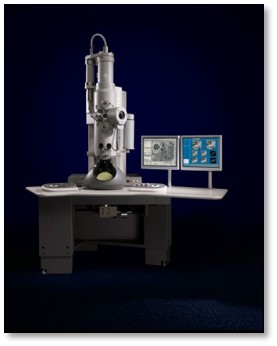 Model: Tecnai Spirit / Image courtesy: FEI Company |
|---|---|
| Microscopy | Model: FEI TECNAI SPIRIT |
| Electron gun | Electron source:  FIELD EMISSION GUN / Accelerating voltage: 300 kV / Illumination mode: FLOOD BEAM FIELD EMISSION GUN / Accelerating voltage: 300 kV / Illumination mode: FLOOD BEAM |
| Electron lens | Mode: BRIGHT FIELD / Nominal defocus max: 2000 nm / Nominal defocus min: 1000 nm |
| Image recording | Electron dose: 51.45 e/Å2 / Film or detector model: FEI FALCON IV (4k x 4k) |
- Processing
Processing
| EM software |
| ||||||||||||
|---|---|---|---|---|---|---|---|---|---|---|---|---|---|
| CTF correction | Type: PHASE FLIPPING AND AMPLITUDE CORRECTION | ||||||||||||
| 3D reconstruction | Resolution: 2.9 Å / Resolution method: FSC 0.143 CUT-OFF / Num. of particles: 152699 / Symmetry type: POINT |
 Movie
Movie Controller
Controller




 PDBj
PDBj




